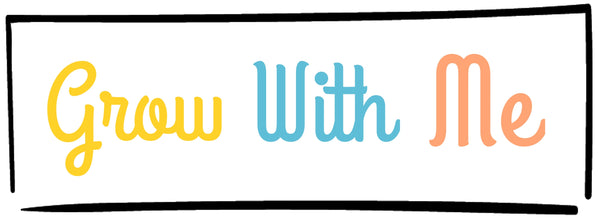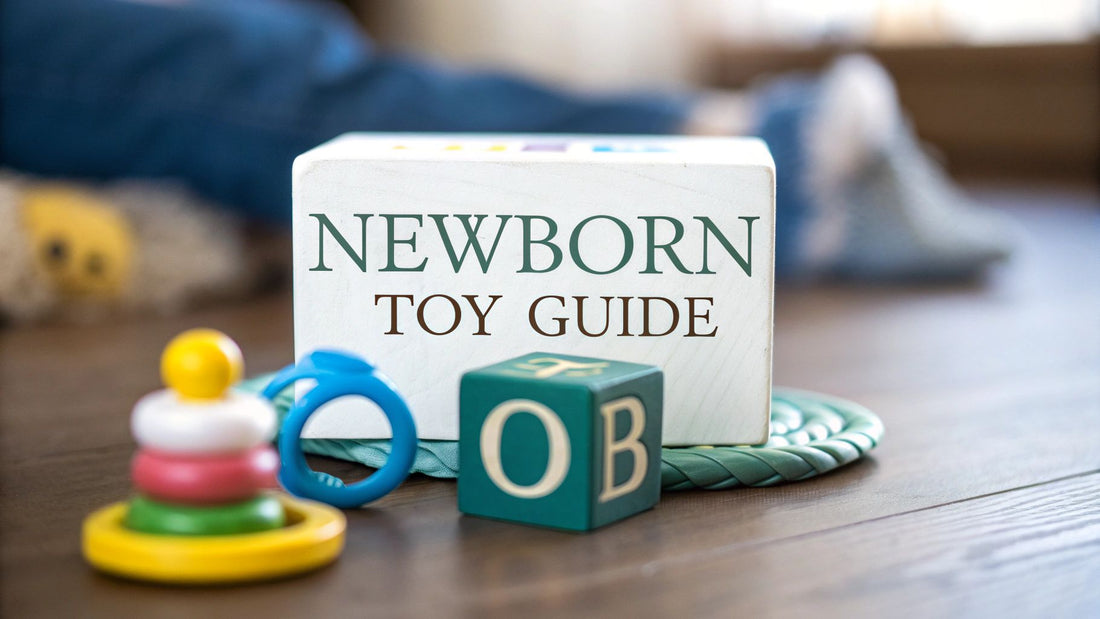
Best Toys for Newborns Development A Practical Guide
Share
When it comes to toys for a newborn, the golden rule is to keep it simple. The very best items are those that gently awaken their core senses. Think high-contrast, black-and-white patterns for their developing vision, a variety of soft textures to explore through touch, and soft, gentle sounds like a rattle to engage their hearing.
Remember, less is more. A handful of carefully selected toys will do far more for your baby's development than a room full of overwhelming clutter.
A Quick Guide to Choosing Newborn Development Toys
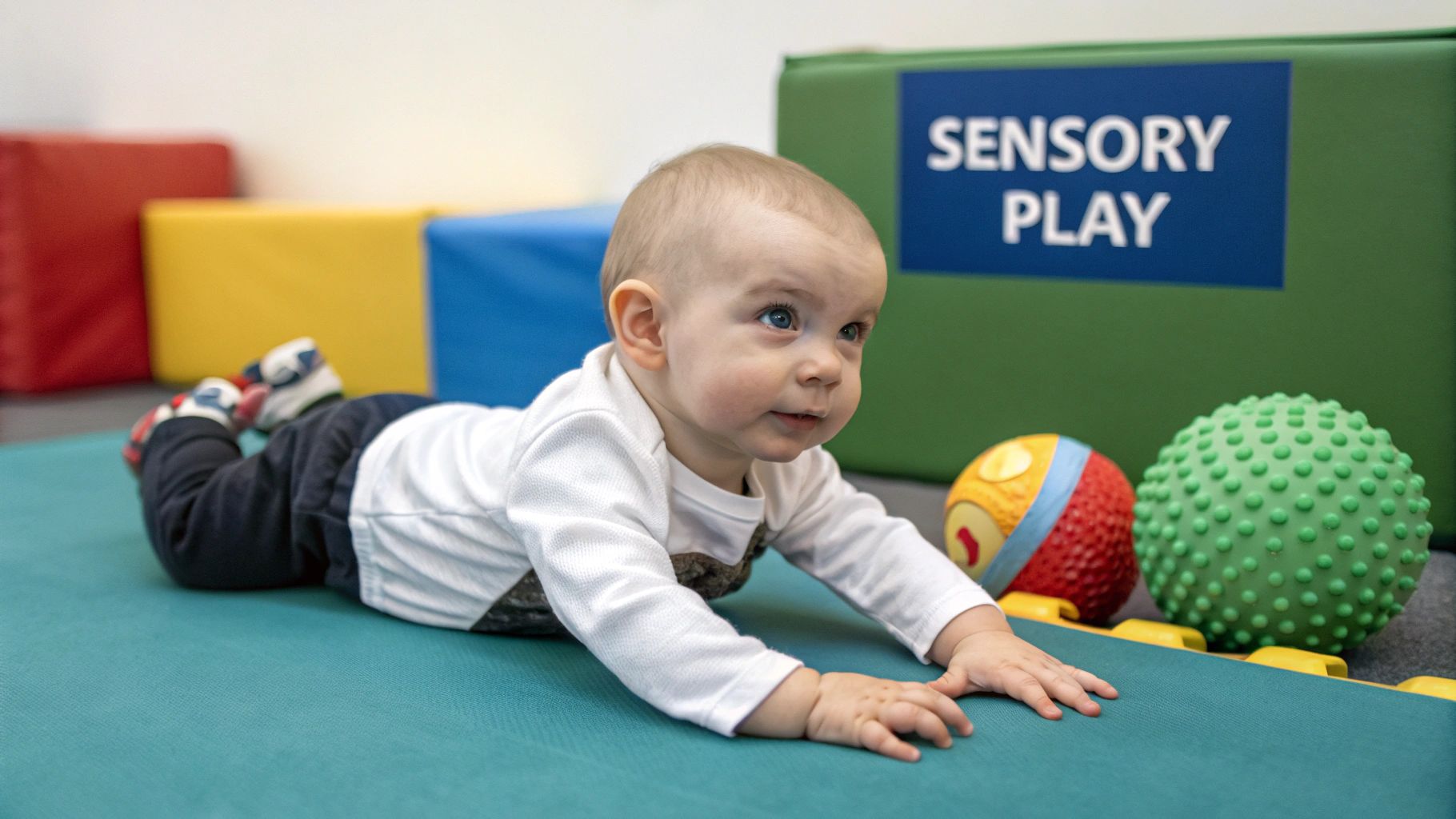
Choosing your baby’s first toys can feel like a massive decision, but it really doesn't need to be. The trick is to forget about fancy brands and instead focus on the types of toys that match their incredible sensory development in these first three months.
Your newborn's world is a fuzzy, brand-new place filled with new sights, sounds, and feelings. The right toys are like little guides on this big adventure, helping them form essential connections in their rapidly growing brain. You can think of their brain like a new computer just starting up – every sensory experience helps to install the foundational software they'll need for all future learning.
Focus on Foundational Senses
At this age, it's all about sensory input. Look for toys that speak to their budding abilities:
- Visual Stimulation: A newborn’s eyesight is still blurry, so they are naturally drawn to bold, high-contrast patterns. Black-and-white flashcards or a simple mobile above their cot are perfect for helping them strengthen their eye muscles and practise focusing.
- Auditory Development: Gentle, soft sounds are best. A simple rattle or a crinkle toy encourages them to turn their head and track sounds with their eyes. It’s a simple action, but it's one of the very first steps in building coordination.
- Tactile Exploration: Soft toys with multiple textures are fantastic for inviting exploration. A plush animal or a play mat with different fabric patches helps them learn about the world one touch at a time.
Simplicity is your greatest tool. The most effective newborn toys are often the most basic, designed to provide just the right amount of stimulation without overwhelming your baby’s developing nervous system.
For parents who want to make sure they always have age-appropriate items on hand, a baby subscription box in the UK can be a brilliant solution. It's a convenient way to get a curated selection of developmentally-focused toys delivered right as your baby needs them.
This guide is here to help you build a small but powerful collection of the best toys for your newborn's development, turning simple playtime into a fantastic opportunity for growth.
How Your Newborn Experiences the World
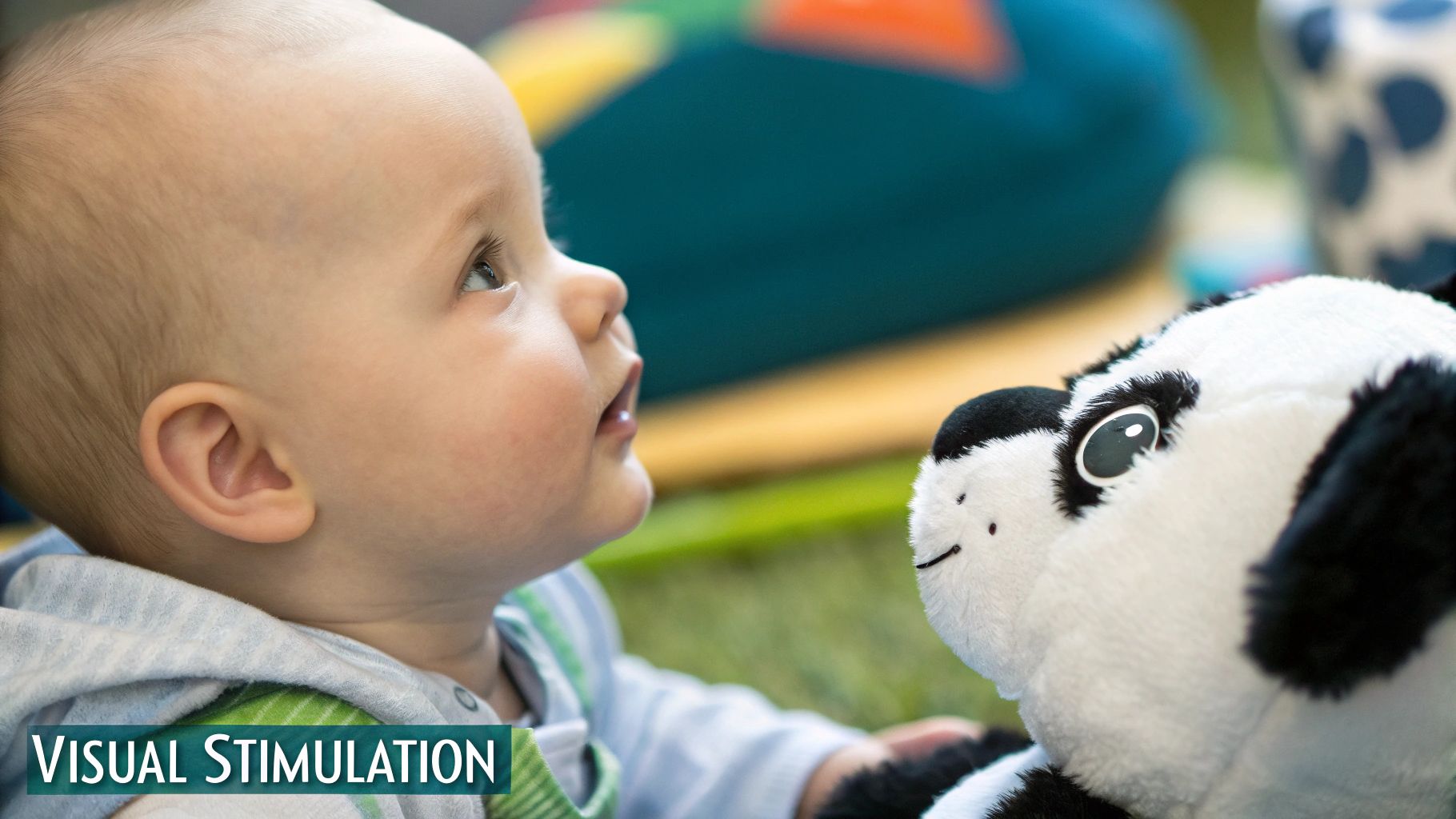
To pick the very best toys for your new baby, it really helps to step into their tiny shoes and see the world from their perspective. For the first three months, your baby is a pure sensory explorer. Their brain is a little sponge, soaking up every new sight, sound, and feeling.
Think about looking through a slightly blurry, frosted window. That’s pretty close to what a newborn's vision is like. They can only really focus on things that are about 20 to 30 centimetres away – which, not coincidentally, is the perfect distance to your face when you’re holding them. It's no wonder your face is their absolute favourite thing to gaze at!
Because their eyesight is still a work in progress, they are naturally drawn to bold, high-contrast images. You might think soft pastels are the way to go, but a simple black-and-white pattern is infinitely more fascinating to them. This isn't just a fun quirk; it’s how they strengthen their eye muscles and learn to focus, building the foundation for a lifetime of seeing clearly.
Hearing and Tuning In
While their sight is getting up to speed, a newborn’s hearing is surprisingly sharp right from day one. They’ve been listening to your voice muffled in the womb for months, so they already recognise its unique pitch and rhythm. This is why simply talking, singing, and reading to them is so incredibly powerful.
Gentle, soothing sounds are a source of comfort, whereas sharp, sudden noises can be quite startling. Their little auditory system is already hard at work, learning to filter different noises and figure out where they're coming from. When you shake a soft rattle just out of sight, you'll see them try to turn their head towards it. That simple movement is actually a huge developmental milestone! It’s them connecting what they hear with what they do.
Your voice is your baby's first and most important auditory 'toy'. It provides comfort, stimulates language centres in the brain, and strengthens your emotional bond more than any object can.
Reading aloud is a fantastic way to engage their hearing. They won't understand the story, of course, but the rhythmic sound of your voice is both calming and stimulating. Exploring the best board books for babies is a wonderful way to start this habit from the very beginning.
The Power of Touch and Reflex
For a newborn, touch is their first language. It’s how they learn about safety, comfort, and even their own body. Soft textures from a plush toy or a silky-smooth blanket provide brand new sensory information that helps their brain start mapping out the world.
You’ve probably also felt their amazing palmar grasp reflex. Pop your finger in their tiny palm, and they’ll instinctively grip it with surprising strength. This isn't a deliberate action just yet, but it's the very beginning of developing their fine motor skills. Toys that are lightweight and easy for their hands to grasp, like simple linking rings, help nudge this reflex towards intentional movement.
Once you understand these sensory starting points, it becomes clear why certain toys are so much more than just objects. You're not just buying a plaything; you're choosing a tool that's perfectly designed for your baby's current stage of discovery.
Understanding UK Toy Safety Standards
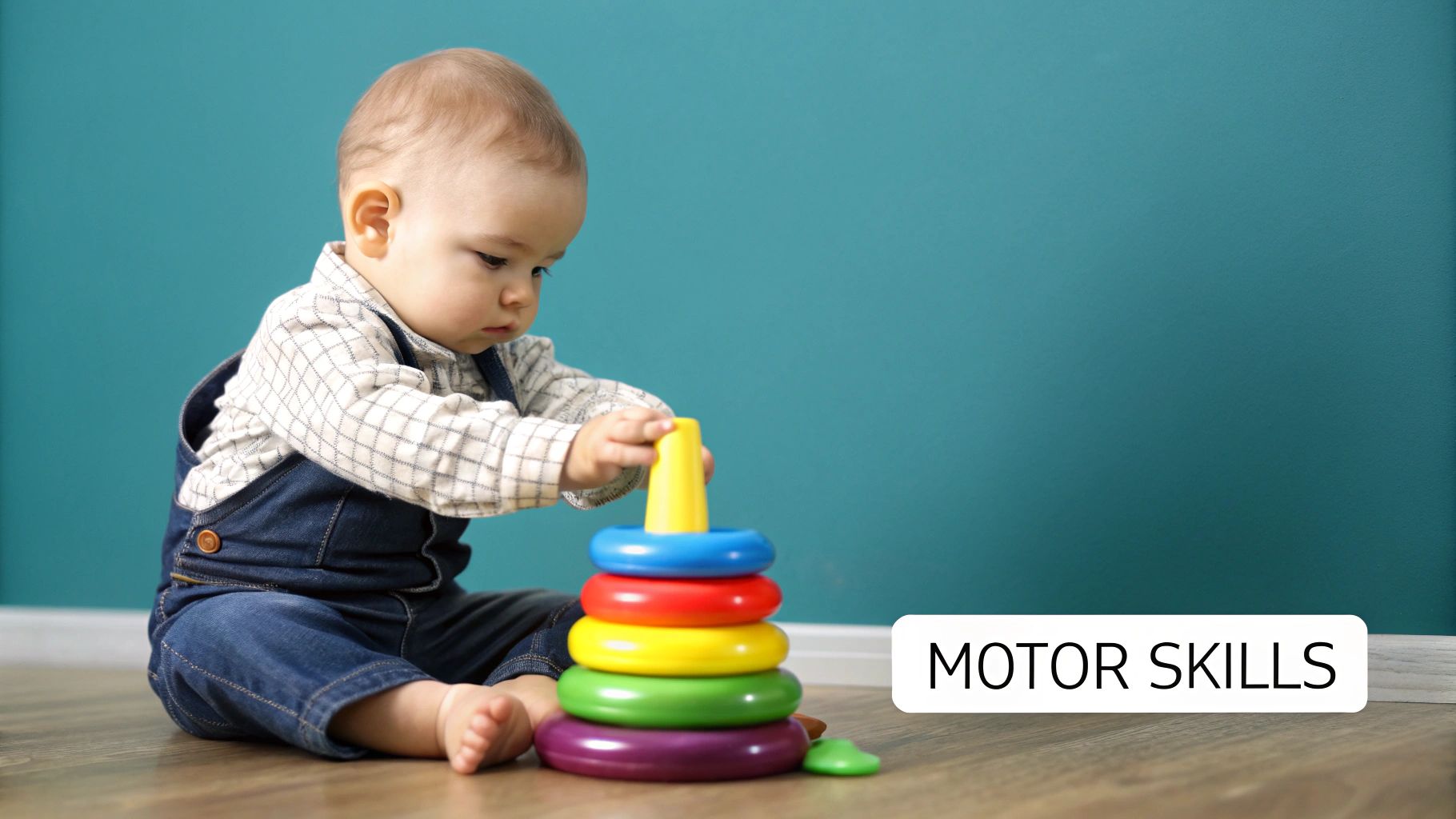
Before a toy can spark a giggle or encourage a new skill, it has to be completely safe. This is the absolute number one priority for newborns, who learn about the world by putting just about everything in their mouths. Trying to figure out toy safety standards can feel a bit overwhelming, but a couple of key symbols are all you really need to know to shop with total confidence.
Thankfully, UK law provides a solid safety net for our little ones. The UK Toys (Safety) Regulations 2011 set out strict rules for any toy aimed at children under 36 months. The law is designed to protect them from physical harm and nasty chemicals, taking into account typical baby behaviours like chewing, grabbing, and dropping.
Essentially, this legislation is our guarantee that a toy has been properly checked before it ever makes it into our homes.
Decoding the Safety Marks
So, when you're looking for the perfect toy for your newborn, your first job is to play detective. Scan the packaging or label for two crucial marks – they're your quickest and most reliable sign that a product is safe and properly regulated.
- The UKCA Mark: This is the UK’s own product safety mark. When you see it, the manufacturer is confirming that the toy meets all the necessary UK safety requirements.
- The CE Mark: You'll often spot this one, sometimes alongside the UKCA mark. It shows that the toy also meets the health, safety, and environmental standards for products sold across Europe.
Think of these marks like a passport. They prove a toy has passed its official checks and is legally allowed to be sold here. If a toy is missing one of these, it’s a massive red flag.
Always remember that your newborn’s safety is non-negotiable. A toy without a UKCA or CE mark has not been verified against UK safety standards and should be avoided, no matter how appealing it looks.
A Practical Safety Checklist for Parents
Beyond the official stamps of approval, your own common sense is your best friend. A quick hands-on check is the final, vital step before you hand any new toy over to your baby.
Here's a simple checklist to run through:
- Check for Small Parts: Make sure there are no little bits that could break off and become a choking hazard. A good rule of thumb is that anything that can fit entirely inside an old 35mm film canister is too small for a baby.
- No Sharp Edges or Points: Run your hands all over the toy. It should feel smooth, with no sharp points, rough patches, or splintery bits that could scratch delicate skin.
- Secure Seams and Attachments: On soft toys, give the seams a gentle tug to make sure they're tightly stitched. Features like eyes and noses should be embroidered on, not plastic beads that could be chewed off.
- Avoid Long Cords or Ribbons: Any cord longer than 22cm (about the width of an A4 page) can be a strangulation risk. Be wary of long ribbons, strings, or loops, especially on toys meant for a cot or playpen.
This diligence is particularly important when buying from online marketplaces, where it can be easier for unregulated sellers to slip through the net. By sticking to reputable UK retailers and keeping an eye out for these key safety features, you can make sure every playtime is a safe and happy one.
Top Sensory Toys for Your Newborn
Alright, now that we've covered your newborn's sensory world and the vital UK safety checks, let's get to the fun part: choosing the best toys to support their incredible growth. It’s not about cluttering the nursery; it's about finding a few key items that are perfectly in tune with their developmental stage. The right toys really are powerful tools for learning and bonding.
It's so tempting to buy armfuls of toys, especially when faced with endless adorable options. It might surprise you to learn that the average child in the UK owns around 238 toys, but more is definitely not better. Research consistently shows that a toy's quality, safety, and suitability for their age are far more important than sheer numbers. You can read more on the impact of carefully chosen toys over at MyBABA.
Engaging Developing Vision
A newborn's vision is still a work in progress, which makes high-contrast items some of the most powerful first toys you can offer. Their eyes aren't quite ready for a full spectrum of colour, but they are expertly tuned to pick out bold, simple patterns.
- High-Contrast Flashcards: Simple black-and-white cards with geometric shapes are like visual dynamite for a newborn. During alert "tummy time," try placing a card about 20-30cm from their face. This simple act encourages them to lift their head and strengthen those crucial neck muscles as they focus.
- Simple Mobiles: A mobile with black-and-white shapes hanging over their cot provides gentle visual stimulation without being overwhelming. As they gaze up, they’re actually practising how to track objects with their eyes—a foundational skill they'll one day use for reading.
Want to dive deeper into creating a stimulating environment? Our complete guide to sensory toys for babies is packed with more ideas for engaging play.
Toys for Auditory Discovery
Your baby's hearing is remarkably sharp from birth, and they’re already busy connecting sounds to the world around them. Gentle noises are fantastic for encouraging them to turn their head, building vital connections between what they hear and how they move.
This is why simple, sound-making toys are so effective.
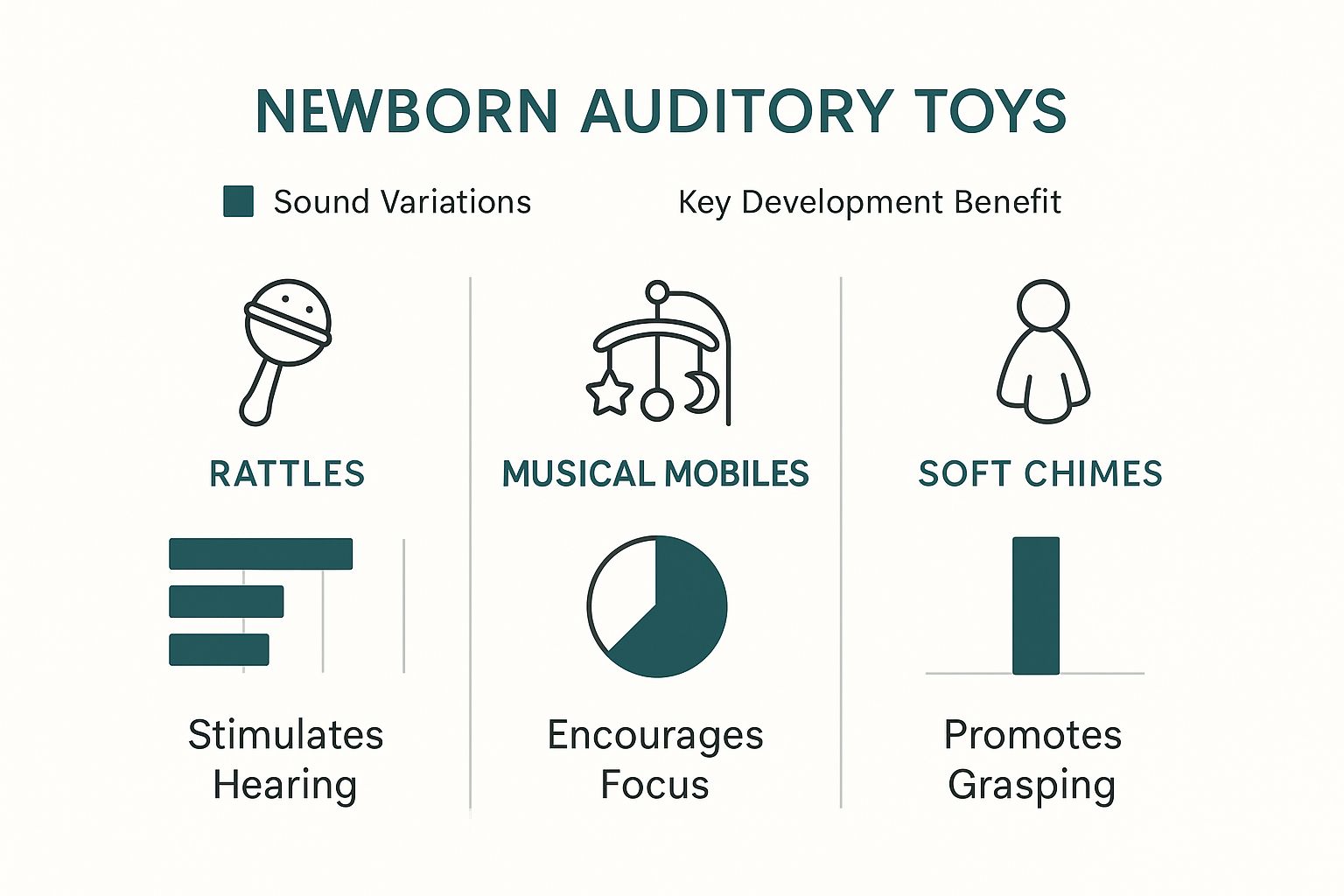
- Soft Rattles: A lightweight rattle is one of the best first toys for newborn development. When you gently shake it to one side of their head, you’ll see them try to turn towards the sound. Little wrist and ankle rattles are also brilliant for helping them discover their own hands and feet.
- Crinkle Toys or Books: That soft crinkling sound from mylar paper inside a toy is utterly fascinating for babies. It gives them instant auditory feedback when they grasp or kick it, teaching them their very first lesson in cause and effect.
Remember, the goal is stimulation, not overstimulation. A single, gentle sound is far more beneficial than a cacophony from a noisy electronic toy. After all, your voice will always be their favourite sound.
Encouraging Physical Milestones
Long before they can roll over or sit up, your newborn is preparing their body for all the big movements to come. This is where play gyms and mats come in, providing a safe and engaging space for this foundational work. They’re designed to inspire reaching, kicking, and grasping—the very building blocks of coordination.
To help you choose the right tools for the job, here’s a quick guide comparing some of the most popular sensory toys.
Sensory Toy Selection Guide for Newborns
| Toy Type | Primary Sense Stimulated | Best Use Case | Safety Check |
|---|---|---|---|
| High-Contrast Cards | Vision | Tummy time; quiet, alert periods to encourage focus and head lifting. | Use sturdy, laminated cards with rounded corners. No small, detachable parts. |
| Soft Rattles | Hearing & Touch | Encouraging head-turning and tracking sounds; cause-and-effect play. | Lightweight, easy to grasp. Ensure no small pieces can break off. Check seams. |
| Crinkle Toys | Hearing & Touch | Grasping practice; provides instant feedback to baby's movements. | Made from baby-safe fabrics. The crinkle material should be securely sewn inside. |
| Play Gym/Mat | Vision, Touch & Hearing | A safe space for tummy time and encouraging reaching and kicking. | Sturdy frame, soft mat. Hanging toys should be lightweight and securely attached. |
| Baby-Safe Mirror | Vision | Tummy time motivation; promotes self-awareness and social skills. | Must be made of non-glass, shatterproof material. Check for sharp edges. |
A quality play mat gives them a soft surface for tummy time, which is absolutely essential for developing the neck, shoulder, and core muscles they’ll need for future mobility. Many come with an arch where you can hang simple, lightweight toys.
Here’s another great tip: place a baby-safe mirror on the mat during tummy time. Babies are fascinated by faces—even their own!—and it can motivate them to push up and stay engaged for longer. By thoughtfully selecting just a few of these sensory-rich items, you’re creating the perfect first "curriculum" to support your baby’s development.
Common Mistakes to Avoid When Buying Baby Toys
Walking down the baby aisle can feel like navigating a minefield of bright colours and big promises. It’s so easy to get caught up in the excitement, but a few common slip-ups can lead to wasted money and, more importantly, can compromise your baby’s safety and development.
Knowing what not to do is just as important as knowing what to buy. Let's walk through some of the most frequent mistakes parents make.
Picking Toys That Are Too Advanced
It’s completely natural to want to give your baby every advantage, but reaching for a toy that’s too complex is a classic misstep. A newborn's nervous system is still incredibly new and sensitive. A toy with flashing lights, loud electronic sounds, and lots of moving parts isn't stimulating in a good way—it's just overwhelming.
Instead of encouraging learning, this sensory overload can actually lead to a fussy, agitated baby who tunes everything out. At this early stage, their brain is wired to process simple, clear information. A toy that's way beyond their current grasp just becomes background noise, not a tool for discovery. Stick with things that match their here-and-now abilities, like a simple high-contrast card they can actually focus on.
The Hidden Dangers of Online Marketplaces
Here’s a big one: buying toys from third-party sellers on major online platforms. The prices can be incredibly tempting, but the safety risks are genuinely frightening. These sellers often operate outside of UK regulations, bypassing the strict safety standards that high-street retailers and trusted brands are legally required to meet.
A recent investigation by the British Toy & Hobby Association (BTHA) in 2022 painted a truly alarming picture. It found that a staggering 90% of toys they tested from popular online marketplaces were unsafe or didn't comply with UK safety laws. The report uncovered serious risks, including small parts that are choking hazards, toxic chemicals in the materials, and even the potential for burns. Since newborns explore the world with their mouths, this is a gamble you just can’t afford to take. You can read all the details in the BTHA's official report.
Your baby's safety has to be the number one priority. The only way to be certain that a toy has been properly tested and is free from hidden dangers is to buy directly from reputable UK brands and retailers you trust.
Falling for the 'More Is Better' Myth
Finally, let's challenge the idea that a mountain of toys equals a mountain of learning. The truth is, the opposite is usually the case. Piling toys up around a baby can be completely overwhelming, making it impossible for them to focus on and properly engage with any single object.
Less is absolutely more here. A small, thoughtfully chosen collection of three to five high-quality, age-appropriate toys is all they need. This minimalist approach gives them enough variety without causing sensory overload, and it actually encourages deeper, more meaningful play as they explore what each item can do.
And remember, the best "toy" your newborn will ever have is you. Your face, your voice, and your touch provide the richest and most important sensory experiences they need for healthy development. Avoid these common mistakes, and you’ll be able to confidently choose a few perfect items to support their incredible journey of discovery.
Your Questions About Newborn Toys Answered
Even when you've got your head around the developmental milestones and safety checklists, the real-world questions always pop up. Let's tackle some of the most common queries I hear from new parents, helping you move from theory to feeling genuinely confident about the toys you choose.
How Many Toys Does a Newborn Actually Need?
Honestly, not many at all. When it comes to newborns, the mantra is always quality over quantity. A small, thoughtfully chosen collection of three to five high-quality, developmentally-friendly toys is more than enough to give them the gentle stimulation they need.
Think of it as a 'capsule wardrobe' of play: a high-contrast mobile, a soft rattle, a crinkly fabric book, and a play mat would be a perfect starting point. It’s easy to forget that newborns can get overstimulated very quickly, and a mountain of toys can easily overwhelm their brand-new nervous systems. And remember, their absolute favourite 'toy' is you – your face, your voice, and your touch are the richest sensory experiences they can have.
When Should I Introduce Toys to My Newborn?
You can start bringing simple sensory toys into their world right from the first few weeks. Just be sure to begin with things that cater specifically to their developing senses. High-contrast black-and-white cards, for instance, are perfect for showing your baby during their quiet, alert moments, even in that very first week.
Around the one-month mark, you could introduce a soft rattle with a gentle sound. Try moving it slowly from side to side to encourage them to track it with their eyes. Don't expect any hands-on, interactive play just yet; this stage is all about gentle exposure. The key is to follow your baby's lead – introduce a toy when they seem calm and receptive, and take it away if they start to get fussy or look tired.
Key Takeaway: The single most important feature in any newborn toy is safety. No matter how brilliant a toy claims to be for development, it's useless if it poses a risk. Always put UKCA/CE marks, durable construction, and age-appropriateness first.
Are Second-Hand Toys Safe for Newborns?
Second-hand toys can be a fantastic, sustainable choice, but you have to be extra vigilant about safety. Only consider items that are in excellent condition. It’s time to put on your detective hat before you let anything near your baby.
- Inspect It Thoroughly: Look for any small parts that could have come loose, creating a choking hazard. Run your hands over it to check for sharp edges, cracks, or other signs of wear and tear.
- Clean and Disinfect: Hard plastic toys should be scrubbed clean and properly disinfected.
- Be Wary of Soft Toys: It's often best to avoid second-hand soft toys unless you know their history and can wash them on a high-temperature setting to kill off any lingering bacteria or allergens.
Always check for a visible UKCA or CE mark and confirm the toy is designed for children under 36 months. If you have any doubt at all, it's always better to be safe and simply pass on it.
Ready to give your baby the perfect, stage-based toys without the guesswork? Grow With Me delivers curated play kits designed by experts to support your child’s development every step of the way. Explore our subscription boxes and start your play journey today at https://shop.growwithmesubscriptionbox.co.uk.
